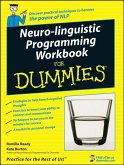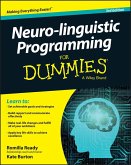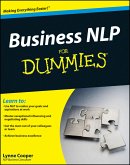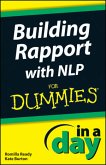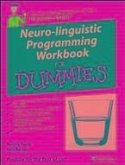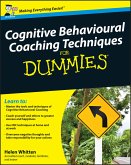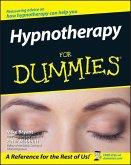

Alle Infos zum eBook verschenken

- Format: PDF
- Merkliste
- Auf die Merkliste
- Bewerten Bewerten
- Teilen
- Produkt teilen
- Produkterinnerung
- Produkterinnerung

Hier können Sie sich einloggen

Bitte loggen Sie sich zunächst in Ihr Kundenkonto ein oder registrieren Sie sich bei bücher.de, um das eBook-Abo tolino select nutzen zu können.
Turn thoughts into positive action with neuro-linguistic programming Neuro-linguistic programming (NLP) has taken the psychology world by storm. So much more than just another quick-fix or a run-of-the-mill self-help technique, NLP shows real people how to evaluate the ways in which they think, strategise, manage their emotional state and view the world. This then enables them to positively change the way they set and achieve goals, build relationships with others, communicate and enhance their overall life skills. Sounds great, right? But where do you begin? Thankfully, that's where this…mehr
- Geräte: PC
- mit Kopierschutz
- eBook Hilfe
- Größe: 8.97MB
![Neuro-Linguistic Programming Workbook For Dummies (eBook, PDF) Neuro-Linguistic Programming Workbook For Dummies (eBook, PDF)]() Romilla ReadyNeuro-Linguistic Programming Workbook For Dummies (eBook, PDF)14,99 €
Romilla ReadyNeuro-Linguistic Programming Workbook For Dummies (eBook, PDF)14,99 €![Neuro-linguistic Programming For Dummies (eBook, ePUB) Neuro-linguistic Programming For Dummies (eBook, ePUB)]() Romilla ReadyNeuro-linguistic Programming For Dummies (eBook, ePUB)18,99 €
Romilla ReadyNeuro-linguistic Programming For Dummies (eBook, ePUB)18,99 €![Business NLP For Dummies (eBook, PDF) Business NLP For Dummies (eBook, PDF)]() Lynne CooperBusiness NLP For Dummies (eBook, PDF)15,99 €
Lynne CooperBusiness NLP For Dummies (eBook, PDF)15,99 €![Building Rapport with NLP In A Day For Dummies (eBook, PDF) Building Rapport with NLP In A Day For Dummies (eBook, PDF)]() Romilla ReadyBuilding Rapport with NLP In A Day For Dummies (eBook, PDF)2,99 €
Romilla ReadyBuilding Rapport with NLP In A Day For Dummies (eBook, PDF)2,99 €![Neuro-Linguistic Programming Workbook For Dummies (eBook, ePUB) Neuro-Linguistic Programming Workbook For Dummies (eBook, ePUB)]() Romilla ReadyNeuro-Linguistic Programming Workbook For Dummies (eBook, ePUB)14,99 €
Romilla ReadyNeuro-Linguistic Programming Workbook For Dummies (eBook, ePUB)14,99 €![Cognitive Behavioural Coaching Techniques For Dummies (eBook, PDF) Cognitive Behavioural Coaching Techniques For Dummies (eBook, PDF)]() Helen WhittenCognitive Behavioural Coaching Techniques For Dummies (eBook, PDF)16,99 €
Helen WhittenCognitive Behavioural Coaching Techniques For Dummies (eBook, PDF)16,99 €![Hypnotherapy For Dummies (eBook, PDF) Hypnotherapy For Dummies (eBook, PDF)]() Mike BryantHypnotherapy For Dummies (eBook, PDF)14,99 €
Mike BryantHypnotherapy For Dummies (eBook, PDF)14,99 €-
-
-
Dieser Download kann aus rechtlichen Gründen nur mit Rechnungsadresse in A, B, BG, CY, CZ, D, DK, EW, E, FIN, F, GR, HR, H, IRL, I, LT, L, LR, M, NL, PL, P, R, S, SLO, SK ausgeliefert werden.
- Produktdetails
- Verlag: John Wiley & Sons
- Seitenzahl: 432
- Erscheinungstermin: 14. September 2015
- Englisch
- ISBN-13: 9781119106135
- Artikelnr.: 43833165
- Verlag: John Wiley & Sons
- Seitenzahl: 432
- Erscheinungstermin: 14. September 2015
- Englisch
- ISBN-13: 9781119106135
- Artikelnr.: 43833165
- Herstellerkennzeichnung Die Herstellerinformationen sind derzeit nicht verfügbar.
traumatic stress disorder (PTSD) 47 Handling phobias 48 Employing the NLP Fast Phobia Cure 49 Accepting That Beliefs and Values Make a Difference 50 Getting to grips with the power of beliefs 50 Working with your values 52 Daydreaming Your Future Reality 58 Chapter 4: Taking Charge of Your Life 59 Taking Control of Your Memory 59 Seeing It Because You Believe It 61 Focusing on blaming others 62 Getting stuck in a problem frame 63 Shifting into the outcome frame 64 Following the Path to Excellence 64 Knowing what you want 65 Becoming smarter than SMART: Creating well
formed outcomes 66 Using the Four
Point Formula for Success 72 Spinning the Wheel of Life 73 Keeping a Dream Diary of Your Goals 74 Just Go for It 76 Part II: Winning Friends and Influencing People 77 Chapter 5: Seeing, Hearing and Feeling Your Way to Better Communication 79 Getting to Grips with the Senses 80 Filtering reality 81 Hearing how people are thinking 83 Listening to the World of Words 86 Glimpsing into the world of synaesthesia 86 Building rapport through words 87 Bringing on the translators 90 Acknowledging the Importance of the Eyes 91 Making the VAK System Work for You 95 Chapter 6: Creating Rapport 97 Knowing Why Rapport is Important 98 Recognising rapport when you see it 99 Identifying people with whom you want to build rapport 99 Introducing Basic Techniques for Building Rapport 102 Sharpening your rapport following eight quick tips 102 Viewing the communication wheel and developing rapport 103 Matching and mirroring 105 Pacing to lead other people successfully 107 Building rapport in virtual communication 108 Knowing How to Break Rapport and Why You May Want To 110 Discovering how to break rapport sensitively 110 Grasping the power of the word 'but' 112 Understanding Other Points of View 113 Exploring perceptual positions 114 Looking into the NLP metämirror 114 Chapter 7: Understanding to Be Understood: Meta Programs 119 Getting to Grips With MetäProgram Basics 120 Looking at meta programs and language patterns 121 Exploring meta programs and behaviour 121 Being Proactive/Reactive 123 Moving Towards/Away From 124 Discovering Options/Procedures 128 Delving Into the Internal/External 129 Going Global/Detailed 130 Recognising Sameness, Sameness with Difference and Difference 133 Tackling Time Perspectives 136 Combining Meta Programs 138 Developing Your MetäProgram Skills 139 Chapter 8: Pushing the Communication Buttons 141 Understanding the Process of Communication 142 Scenario 1 143 Scenario 2 144 Introducing the NLP Communication Model 144 Processing pieces of information 145 Getting to grips with individual responses 148 Giving Effective Communication a Try 155 Part III: Opening the Toolkit 157 Chapter 9: Dropping Anchors 159 Starting Out With NLP Anchors 160 Setting an anchor and building yourself a resourceful state 161 Eliciting and calibrating states 162 Developing your own repertoire of anchors 164 Recognising your own anchors 165 Going Through the Emotions: Sequencing States 166 Altering states with anchors 167 Getting with the baroque beat 168 Walking in someone else's shoes 169 Becoming Sophisticated with Anchors 170 Changing negative anchors 170 Deploying stage anchors 172 A Final Point About Anchors 174 Chapter 10: Sliding the Controls of Your Experience 175 Recording Your Experiences with Your Submodalities 176 Grasping the Basic Info: What You Need to Know Before You Begin 177 Associating or dissociating 177 Defining the details of your memories 178 Getting a little practice 182 Understanding Your Critical Submodalities 183 Making Real
Life Changes 184 Removing the pain from an experience 185 Changing a limiting belief 185 Creating an empowering belief 186 Getting rid of that backache 187 Using the swish 188 Submodalities Worksheet 189 Chapter 11: Working with the Logical Levels 191 Understanding Logical Levels 191 Asking the right questions 193 Taking logical levels step
by
step 194 Employing practical uses for logical levels 195 Finding the Right Lever for Change 196 Environment 197 Behaviour 198 Capabilities and skills 199 Beliefs and values 200 Identity 203 Purpose 204 Figuring Out Other People's Levels: Language and Logical Levels 205 Teambuilding at Work and Play: A Logical Levels Exercise 205 Chapter 12: Driving Habits: Uncovering Your Secret Programs 207 Witnessing the Evolution of Strategies 208 The S-R model 208 The TOTE model 208 The NLP strategy = TOTE + modalities 209 The NLP strategy model in action 210 The Eyes Have It: Recognising Another's Strategy 211 Flexing Your Strategy Muscles 213 Linking strategies and the logical levels model 214 Acquiring new capabilities 214 Recoding your programs 216 Grasping the importance of the 'how' 216 Using NLP Strategies for Love and Success 218 Loving the deep love strategy 218 Influencing people with strategies 220 Spelling out the NLP spelling strategy 221 Chapter 13: Travelling in Time to Improve Your Life 225 Understanding How Your Memories Are Organised 227 Discovering Your Time Line 228 Changing Your Time Line 229 Travelling Along Your Time Line to a Happier You 232 Releasing negative emotions and limiting decisions 233 Finding forgiveness 236 Comforting the younger you 236 Getting rid of anxiety 236 Creating a better future 238 Chapter 14: Ensuring Smooth Running Below Decks 241 Getting to Grips with a Hierarchy of Conflict 242 Drifting from Wholeness to Parts 244 Understanding a part's intentions 244 Getting to the heart of the problem 245 Help! I'm in Conflict with Myself 246 Listening to your unconscious mind 246 Taking sides 246 Becoming Whole: Integrating Your Parts 247 Trying the visual squash technique 247 Reframing - as if 249 Resolving Bigger Conflicts 251 Part IV: Using Words to Entrance 253 Chapter 15: Getting to the Heart of the Matter: The Meta Model 255 Gathering Specific Information with the Meta Model 256 Deletion - you're so vague 259 Generalisation - beware the always, musts and shoulds 261 Distortion - that touch of imagination 264 Using the Meta Model 266 Taking two simple steps 266 Remembering a few caveats 267 Chapter 16: Unleashing the Power of Hypnosis 269 Discovering the Language of Trance - the Milton Model 270 Comparing language patterns and the Milton Model 271 Meeting other aspects of the Milton Model 272 Finding your own preferred model 274 Understanding the art of vagueness and why it's important 274 Going Deeper into Hypnosis 276 Becoming comfortable with the idea of hypnosis 277 Experiencing everyday trances 279 Chapter 17: Telling Tales to Reach the Unconscious: Stories, Fables and Metaphors 283 Processing Stories and Metaphors 284 Understanding the Stories of Your Life 284 Getting to grips with storytelling basics 284 Working on your storytelling 285 Passing on a gift to the next generation 287 Grasping the Power of Metaphors 287 Using metaphors in NLP 288 Applying metaphors to find new solutions 289 Employing direct and indirect metaphors 290 Building Your Own Stories 291 Using the personal story builder journal 292 Discovering more ways to flex your storytelling muscles 293 Using subtle persuasion 294 Adding loops to your story: And this reminds me of 295 Chapter 18: Asking the Right Questions 299 Question
Asking Tips and Strategies 300 Cleaning up your language: Removing bias 300 Recognising that the way you behave is what counts 305 Pressing the pause button 305 Testing your questions 306 Making positive statements the norm 306 Figuring Out What You Want 306 What do I want? 307 What's that going to do for me? 307 Asking Questions to Help Make Decisions 308 Challenging Limiting Beliefs 309 Finding the Right Person for the Job: A Question of Motivation 310 What do you want in your work? 311 Why is that important? 311 How do you know that you've done a good job? 312 Why did you choose your current line of work? 312 Checking In with Yourself 313 Part V: Integrating Your Learning 315 Chapter 19: Dipping into Modelling 317 Developing New Skills through Modelling 318 Recognising that modelling is a natural human talent 320 Getting to a deeper structure 321 Discovering Modelling Case Studies 322 The reluctant exemplar 323 The rainmakers' dance 324 Key Stages in Modelling 325 Knowing your modelling outcome 326 Identifying your exemplar 326 Finding a modelling method you can work with 327 Gathering your data 328 Building your model 329 Testing the prototype 330 Refining for simplicity 331 Chapter 20: Making Change Easier 335 Finding Clarity and Direction 336 Understanding the Structure of Change 337 The Kubler
Ross grief cycle 337 Applying the NLP logical levels 340 Holding On to Values 346 Grasping the Importance of Clear Communication 346 Creating the Mindset for Change 348 Letting go of fear 348 Being willing to experiment 351 Getting Help on the Way 352 Strengthening resources 352 Pacing the future 353 Planning the road map 353 Taking One Step Forward 354 Making that initial move 354 Celebrating and gaining closure 354 Part VI: The Part of Tens 357 Chapter 21: Ten Applications of NLP 359 Developing Yourself 359 Managing Your Personal and Professional Relationships 360 Negotiating a Win-Win Solution 361 Motivating and Leading Staff 362 Creating Powerful Presentations 363 Managing Your Time and Precious Resources 365 Being Coached to Success 365 Using NLP to Support Your Health 366 Connecting to Your Audience: Advice for Trainers and Educators 367 Getting the Best Job for You 369 Chapter 22: Ten Books to Add to Your Library 371 Changing Belief Systems with NLP 371 The User's Manual for the Brain 371 Core Transformation 372 Frogs into Princes 372 Influencing with Integrity 372 An Insider's Guide to Sub
Modalities 372 The Magic of Metaphor 373 Metaphors We Live By 373 Persuasion Skills Black Book 373 Presenting Magically 373 Chapter 23: Ten Films That Include NLP Processes 375 Avatar 375 Ferris Bueller's Day Off 376 Dune 377 As Good as It Gets 378 Bend It like Beckham 379 Field of Dreams 380 Gattaca 380 The Matrix 381 Stand and Deliver 381 Philomena 382 NLP at the Cinema 383 Part VII: Appendixes 385 Appendix A: Resource List 387 Contacting the Authors 387 Online Resources 388 Appendix B: Rapport Building 389 Appendix C: The Well
Formed Outcome Checklist 391 Appendix D: Submodalities Worksheet 393 Submodalities Worksheet 394 Index 395
traumatic stress disorder (PTSD) 47 Handling phobias 48 Employing the NLP Fast Phobia Cure 49 Accepting That Beliefs and Values Make a Difference 50 Getting to grips with the power of beliefs 50 Working with your values 52 Daydreaming Your Future Reality 58 Chapter 4: Taking Charge of Your Life 59 Taking Control of Your Memory 59 Seeing It Because You Believe It 61 Focusing on blaming others 62 Getting stuck in a problem frame 63 Shifting into the outcome frame 64 Following the Path to Excellence 64 Knowing what you want 65 Becoming smarter than SMART: Creating well
formed outcomes 66 Using the Four
Point Formula for Success 72 Spinning the Wheel of Life 73 Keeping a Dream Diary of Your Goals 74 Just Go for It 76 Part II: Winning Friends and Influencing People 77 Chapter 5: Seeing, Hearing and Feeling Your Way to Better Communication 79 Getting to Grips with the Senses 80 Filtering reality 81 Hearing how people are thinking 83 Listening to the World of Words 86 Glimpsing into the world of synaesthesia 86 Building rapport through words 87 Bringing on the translators 90 Acknowledging the Importance of the Eyes 91 Making the VAK System Work for You 95 Chapter 6: Creating Rapport 97 Knowing Why Rapport is Important 98 Recognising rapport when you see it 99 Identifying people with whom you want to build rapport 99 Introducing Basic Techniques for Building Rapport 102 Sharpening your rapport following eight quick tips 102 Viewing the communication wheel and developing rapport 103 Matching and mirroring 105 Pacing to lead other people successfully 107 Building rapport in virtual communication 108 Knowing How to Break Rapport and Why You May Want To 110 Discovering how to break rapport sensitively 110 Grasping the power of the word 'but' 112 Understanding Other Points of View 113 Exploring perceptual positions 114 Looking into the NLP metämirror 114 Chapter 7: Understanding to Be Understood: Meta Programs 119 Getting to Grips With MetäProgram Basics 120 Looking at meta programs and language patterns 121 Exploring meta programs and behaviour 121 Being Proactive/Reactive 123 Moving Towards/Away From 124 Discovering Options/Procedures 128 Delving Into the Internal/External 129 Going Global/Detailed 130 Recognising Sameness, Sameness with Difference and Difference 133 Tackling Time Perspectives 136 Combining Meta Programs 138 Developing Your MetäProgram Skills 139 Chapter 8: Pushing the Communication Buttons 141 Understanding the Process of Communication 142 Scenario 1 143 Scenario 2 144 Introducing the NLP Communication Model 144 Processing pieces of information 145 Getting to grips with individual responses 148 Giving Effective Communication a Try 155 Part III: Opening the Toolkit 157 Chapter 9: Dropping Anchors 159 Starting Out With NLP Anchors 160 Setting an anchor and building yourself a resourceful state 161 Eliciting and calibrating states 162 Developing your own repertoire of anchors 164 Recognising your own anchors 165 Going Through the Emotions: Sequencing States 166 Altering states with anchors 167 Getting with the baroque beat 168 Walking in someone else's shoes 169 Becoming Sophisticated with Anchors 170 Changing negative anchors 170 Deploying stage anchors 172 A Final Point About Anchors 174 Chapter 10: Sliding the Controls of Your Experience 175 Recording Your Experiences with Your Submodalities 176 Grasping the Basic Info: What You Need to Know Before You Begin 177 Associating or dissociating 177 Defining the details of your memories 178 Getting a little practice 182 Understanding Your Critical Submodalities 183 Making Real
Life Changes 184 Removing the pain from an experience 185 Changing a limiting belief 185 Creating an empowering belief 186 Getting rid of that backache 187 Using the swish 188 Submodalities Worksheet 189 Chapter 11: Working with the Logical Levels 191 Understanding Logical Levels 191 Asking the right questions 193 Taking logical levels step
by
step 194 Employing practical uses for logical levels 195 Finding the Right Lever for Change 196 Environment 197 Behaviour 198 Capabilities and skills 199 Beliefs and values 200 Identity 203 Purpose 204 Figuring Out Other People's Levels: Language and Logical Levels 205 Teambuilding at Work and Play: A Logical Levels Exercise 205 Chapter 12: Driving Habits: Uncovering Your Secret Programs 207 Witnessing the Evolution of Strategies 208 The S-R model 208 The TOTE model 208 The NLP strategy = TOTE + modalities 209 The NLP strategy model in action 210 The Eyes Have It: Recognising Another's Strategy 211 Flexing Your Strategy Muscles 213 Linking strategies and the logical levels model 214 Acquiring new capabilities 214 Recoding your programs 216 Grasping the importance of the 'how' 216 Using NLP Strategies for Love and Success 218 Loving the deep love strategy 218 Influencing people with strategies 220 Spelling out the NLP spelling strategy 221 Chapter 13: Travelling in Time to Improve Your Life 225 Understanding How Your Memories Are Organised 227 Discovering Your Time Line 228 Changing Your Time Line 229 Travelling Along Your Time Line to a Happier You 232 Releasing negative emotions and limiting decisions 233 Finding forgiveness 236 Comforting the younger you 236 Getting rid of anxiety 236 Creating a better future 238 Chapter 14: Ensuring Smooth Running Below Decks 241 Getting to Grips with a Hierarchy of Conflict 242 Drifting from Wholeness to Parts 244 Understanding a part's intentions 244 Getting to the heart of the problem 245 Help! I'm in Conflict with Myself 246 Listening to your unconscious mind 246 Taking sides 246 Becoming Whole: Integrating Your Parts 247 Trying the visual squash technique 247 Reframing - as if 249 Resolving Bigger Conflicts 251 Part IV: Using Words to Entrance 253 Chapter 15: Getting to the Heart of the Matter: The Meta Model 255 Gathering Specific Information with the Meta Model 256 Deletion - you're so vague 259 Generalisation - beware the always, musts and shoulds 261 Distortion - that touch of imagination 264 Using the Meta Model 266 Taking two simple steps 266 Remembering a few caveats 267 Chapter 16: Unleashing the Power of Hypnosis 269 Discovering the Language of Trance - the Milton Model 270 Comparing language patterns and the Milton Model 271 Meeting other aspects of the Milton Model 272 Finding your own preferred model 274 Understanding the art of vagueness and why it's important 274 Going Deeper into Hypnosis 276 Becoming comfortable with the idea of hypnosis 277 Experiencing everyday trances 279 Chapter 17: Telling Tales to Reach the Unconscious: Stories, Fables and Metaphors 283 Processing Stories and Metaphors 284 Understanding the Stories of Your Life 284 Getting to grips with storytelling basics 284 Working on your storytelling 285 Passing on a gift to the next generation 287 Grasping the Power of Metaphors 287 Using metaphors in NLP 288 Applying metaphors to find new solutions 289 Employing direct and indirect metaphors 290 Building Your Own Stories 291 Using the personal story builder journal 292 Discovering more ways to flex your storytelling muscles 293 Using subtle persuasion 294 Adding loops to your story: And this reminds me of 295 Chapter 18: Asking the Right Questions 299 Question
Asking Tips and Strategies 300 Cleaning up your language: Removing bias 300 Recognising that the way you behave is what counts 305 Pressing the pause button 305 Testing your questions 306 Making positive statements the norm 306 Figuring Out What You Want 306 What do I want? 307 What's that going to do for me? 307 Asking Questions to Help Make Decisions 308 Challenging Limiting Beliefs 309 Finding the Right Person for the Job: A Question of Motivation 310 What do you want in your work? 311 Why is that important? 311 How do you know that you've done a good job? 312 Why did you choose your current line of work? 312 Checking In with Yourself 313 Part V: Integrating Your Learning 315 Chapter 19: Dipping into Modelling 317 Developing New Skills through Modelling 318 Recognising that modelling is a natural human talent 320 Getting to a deeper structure 321 Discovering Modelling Case Studies 322 The reluctant exemplar 323 The rainmakers' dance 324 Key Stages in Modelling 325 Knowing your modelling outcome 326 Identifying your exemplar 326 Finding a modelling method you can work with 327 Gathering your data 328 Building your model 329 Testing the prototype 330 Refining for simplicity 331 Chapter 20: Making Change Easier 335 Finding Clarity and Direction 336 Understanding the Structure of Change 337 The Kubler
Ross grief cycle 337 Applying the NLP logical levels 340 Holding On to Values 346 Grasping the Importance of Clear Communication 346 Creating the Mindset for Change 348 Letting go of fear 348 Being willing to experiment 351 Getting Help on the Way 352 Strengthening resources 352 Pacing the future 353 Planning the road map 353 Taking One Step Forward 354 Making that initial move 354 Celebrating and gaining closure 354 Part VI: The Part of Tens 357 Chapter 21: Ten Applications of NLP 359 Developing Yourself 359 Managing Your Personal and Professional Relationships 360 Negotiating a Win-Win Solution 361 Motivating and Leading Staff 362 Creating Powerful Presentations 363 Managing Your Time and Precious Resources 365 Being Coached to Success 365 Using NLP to Support Your Health 366 Connecting to Your Audience: Advice for Trainers and Educators 367 Getting the Best Job for You 369 Chapter 22: Ten Books to Add to Your Library 371 Changing Belief Systems with NLP 371 The User's Manual for the Brain 371 Core Transformation 372 Frogs into Princes 372 Influencing with Integrity 372 An Insider's Guide to Sub
Modalities 372 The Magic of Metaphor 373 Metaphors We Live By 373 Persuasion Skills Black Book 373 Presenting Magically 373 Chapter 23: Ten Films That Include NLP Processes 375 Avatar 375 Ferris Bueller's Day Off 376 Dune 377 As Good as It Gets 378 Bend It like Beckham 379 Field of Dreams 380 Gattaca 380 The Matrix 381 Stand and Deliver 381 Philomena 382 NLP at the Cinema 383 Part VII: Appendixes 385 Appendix A: Resource List 387 Contacting the Authors 387 Online Resources 388 Appendix B: Rapport Building 389 Appendix C: The Well
Formed Outcome Checklist 391 Appendix D: Submodalities Worksheet 393 Submodalities Worksheet 394 Index 395

